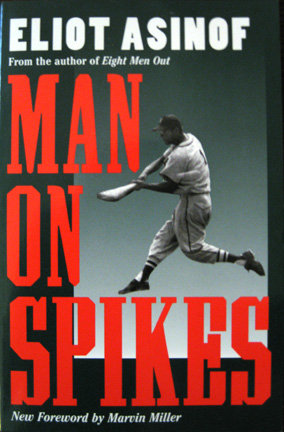Many of the pieces contained here were written in the press boxes, very close to deadline, with the stranger next to me typing a lot quicker. When sportswriters describe other sportswriters, good is high praise, quick is the ultimate. (The two words, quikc and good, make the work sound almost lewd. Me? I never got it for free and I never will.) The deadline is the problem, the enemy. It is there, at the same time, every night. You stand still and it comes closer. You can’t fake it out because it doesn’t move. It grows shorter and towers over you. It doesn’t understand that you want a better word than fast to describe a baserunner. Very fast is very bad. Fleet is out. Swift, nimble, speedy. No, no, no. Fast is starting to look better. There’s coffee spilled on my notes, you know in your heart that the press lounge has run out of beer, and now the stranger is on the telephone telling someone named Sweetie that he’s on the way.
On those days I write in the Daily News‘ sports department, and the ax of a deadline isn’t about to drop immediately, when you might think I have words enough and time, it suddenly becomes important to play chicken with the blade. So I shmooze with the guys in the office, go downstairs for another cup of cardboard coffee, call home, anybody’s home, until I have finally arrived at the moment I dread: the sports editor standing over me and saying, “Where is it?” (This is what you answer, kids. You say five minutes. And not to worry. If you miss once, nothing happens. If you miss too many times, they make you sports editor.)
And here’s John Schulian remembering his friend.
It was Vic Ziegel who once began a story with these immortal words: “The game is never over until the last man is out, the New York Post learned late last night.” If I had a nickel for every baseball writer who has paraphrased or just plain stolen that sentence, I might be able to afford a box seat at a Yankee game.
But those 19 words, no matter how often they appeared in one form or another under someone else’s byline, would always belong to Vic. He took a cliché and, with one deft addition, told his readers that he had written about a game, not the end of the world. Better still, he was setting the stage for a story filled with fun and whimsy. It would also be wise and free of self-importance, because those were trademarks of Vic’s work, too. Most of all, though, his story was going to make people laugh.
Making people laugh was what Vic did best until he died the other day, at 72, and turned my smile, and the smiles of everybody else that knew him, upside down. At the old Dorothy Schiff Post, he tickled funny bones by writing a sports advice column he called “Dear Flabby.” When Red Smith invited him to go to the horse races in some exotic, Ali-inspired locale -– oh, did Vic love the horses -– the next thing he knew, Red had written a column featuring a character named “Bet a Million” Ziegel.
And then there was a story that never made print, the one Vic told on himself about his turn as a hockey writer. The old one had left the Post, and when the new one couldn’t start for a couple of weeks, Vic volunteered the fill in even though hockey left him cold. Somehow he survived. He was such a team guy, in fact, that he even escorted the new man to the first game he covered. Soon after the puck was dropped, the new man began waxing rhapsodic about the action in the crease.
“The crease?” Vic Ziegel, hockey expert, said. “What’s the crease?”
As the story comes back to me, I can hear him laughing. Not loudly -– there was nothing loud about him -– but with the joy he got from telling a funny story well. And if he was the punch line, so what? We’re all punch lines at one point or another in our lives.
He and I might have qualified in that regard when we wrote for P.M. papers–Vic the Post, me the Chicago Daily News–and still struggled to make our deadlines. It was funny for everybody except us and the desk men who were waiting to slap headlines on our copy as dawn came creeping. For all I know, that was how our friendship was born: We were the last two guys in the pressroom. The only thing I can tell you for sure, though, is that we met at the Muhammad Ali-Alfredo Evangelista fight outside Washington, D.C., in 1977, and we became friends, just like that.
It was one more stunning development in the year and a half or so that saw me go from cityside reporter in Baltimore to sportswriter at the Washington Post to columnist in Chicago. Here was Vic, whose work in the New York Post had been making me laugh since the first time I picked up the paper, in 1968, and he was giving me his phone number and calling me “pal” and treating me as if I belonged in the kind of company he kept in Manhattan. He had worked with Leonard Shecter, Larry Merchant, Pete Hamill, and Murray Kempton, and I’d read in the Village Voice that he hung out at the ultimate writers’ bar, the Lion’s Head. Now he was my friend — how cool was that?
There was a grace and good-heartedness about Vic that never wavered throughout the 33 years I knew him. He took me to the Lion’s Head for my first visit, and made a point of introducing me to Hamill and Joel Oppenheimer and Joe Flaherty, towering figures in the pecking order in my head.
When I was married and my wife and I visited New York, Vic and his wife, the pluperfect Roberta, hosted a brunch in our honor at their apartment, and who should show up but Wilfred Sheed, another writing hero. Vic knew the Italian restaurants I should eat at, and the movies I should see (especially if they were film noir), and the old jazz I should be aware of, by Bix Beiderbecke and Jellyroll Morton. I’m partial to country music myself, but one rainy night Vic picked me up to go to dinner and then abruptly pulled his car to a stop on a side street so I could listen to what he thought was the perfect blending of our sensibilities: Jimmie Rodgers, the Singing Brakeman, backed by Louis Armstrong. If a goy from Salt Lake City may say such a thing, he was the ultimate mensch.
There are people who knew Vic longer than I did, and there are people who knew him better, but I consider myself lucky to have spent the time I did reading him and hanging out with him. The last time was after last year’s Breeders’ Cup at Santa Anita. He stayed for a couple of days in the room where I keep my crime novels and a jukebox that I’m ashamed to say has only one jazz CD on it, Miles Davis’ “Kind of Blue.” He had aged and he seemed less sure of himself physically, but if he had been diagnosed with the cancer that ultimately killed him, he never breathed a word of it. He wanted to talk, to laugh, to eat, and when I suggested that we watch The Friends of Eddie Coyle, he was up for that, too. He took the sofa, I took the easy chair, and we were both sound asleep before we got 20 minutes into the movie. It’s what old guys do. Then they say goodbye and hope they’ll see each other again.
When Vic was back in New York, he told me about the health problems that had begun to dog him, though still with no mention of cancer. But I’m not sure I ever told him about the anthology of boxing writing that George Kimball, another old friend, and I are putting together. I should have, because he’s in the book with a blissfully funny story he wrote for Inside Sports 30 years ago about the devoutly unfunny Roberto Duran. The story opens with Vic’s description of two chinchillas, Ralph and Steve, who live in a window cage in New York’s fur district. Now nobody will ever open another boxing story with chinchillas named Ralph and Steve, damn it.



























